What he calls “the most ambitious package ever” will see thousands of miles of protected cycle lanes built, updates made to the Highway Code, and improved legal protection for cyclists.
Mr Johnson said he wants to see “more work done to get motorists to understand that we are all going to be sharing the roads, going to be sharing it with cyclists, so be respectful, be courteous.”
He added: "I really believe that protected cycle lanes are essential to give people the confidence people need, many people aren't very brave or confident cyclists."
"Things have been improving but there's still a long way to go."
The government has committed to reducing traffic and improving air quality by creating more “low traffic neighbourhoods” alongside 12 bike-friendly areas, or ‘Mini Hollands’.
The Government also made 50,000 Fix Your Bike vouchers available from last night (Tues 28th), to be used towards the costs of making a bike safe.
The Fix Your Bike website crashed due to overwhelming demand but is back and releasing vouchers gradually to reflect the capacity of bike repairers.
- The Highway Code – UK road signs and what they mean
- Coronavirus (COVID-19): Answering drivers’ questions
- What is road rage and how can you avoid it?
- Cycling funding boost
Transport Secretary, Grant Shapps said: “We’ve got a once in a lifetime opportunity to create a shift in attitudes for generations to come, and get more people choosing to cycle or walk as part of their daily routine.
“The measures we’ve set out today in this revolutionary plan will do just that. No matter your age, how far you’re travelling, or your current confidence on a bike – there are plans to help and support you.
It’s believed that just a 5% increase in cycling would save 8 million car journeys, 9 million rail journeys and 13 million bus journeys as the nation returns to work.
Department for Transport figures show there has been a surge in cycling following the coronavirus outbreak.
Cycling usage nearly doubled over the weekend of July 18/19 when compared with the equivalent day in the first week of March.
Monday July 20 - the most recent weekday for which data is available - saw cycling at 146% of pre-lockdown levels.

Breakdown cover from £5.29 a month for Standard cover*
• Cheaper than AA Price Promise or we’ll beat it by 20%^
• We get to most breakdowns in 60 mins or less
• Our patrols fix 4/5 breakdowns on the spot

















